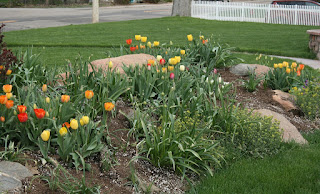If you’ve been looking for ways to bring more color and interest
to your spring garden, planting flowering bulbs is a great place to start. The
keys to achieving this profusion of early season color is to get started now.
Available in a rainbow of colors, these hardy bulbs start showing
up in early spring when the crocus poke their heads up through the snow,
followed soon by the daffodils and then a parade of tulips. The best time
to plant these flowering bulbs is now, in October. The soil temperature is
cooler, but still warm enough to allow the bulbs to root before the ground
freezes.
Begin by selecting quality bulbs. Choose bulbs that are firm and light
tan in color. As you’re selecting your hardy bulbs, consider bloom time.
Planting combinations of early, mid, and late-season bulbs will extend the spring
flowering season. Save the tag or mark the bag so you will remember the variety.
Crocuses are the earliest of the
spring blooming bulbs, followed by daffodils, hyacinths and then tulips –
early, mid, and late. As a general
guideline, early tulips will bloom late March to mid-April. Tulips marked mid-season
will bloom mid-April to early May. Tulips labeled late will bloom from early to
mid-May. Bloom time can vary depending on where bulbs are planted in the
landscape as well as how deep they’re planted.
For example, the soil around a sunny
area near a foundation will warm up sooner that other places in the garden and
bulbs may begin to emerge. If this happens, throw a 5” to 6” layer of mulch on
the planting bed. This will keep the soil cooler and slow bulb growth.
For added interest, consider a few of
the specialty bulbs such as Anemones, or Grape Hyacinths.
Bulbs are available in individual containers or as pre-packaged
assortments. Loose-packed bulbs allow you to mix and match color, height, and
bloom time. Pre-packed bulbs are convenient. The arrangement is ready for
you to take home and plant. That said, choosing from containers allows you to
select each bulb individually.
When planning your bulb garden, it’s
important to decide whether you’re going to plant a formal bed or scatter the
bulbs throughout your landscape for a more natural look. There are several
advantages to planting your bulbs in your perennial beds or open spaces. You’ll
be adding early color to an otherwise bare space in your gardens and as your
perennials emerge, they’ll help mask the bulb foliage as it fades.
Whether you choose a natural look or a more formal planting, your
bulbs will bloom best if you plant them in a site where they’ll receive at
least six hours of sunlight. Prepare the site by amending the existing soil
with organic material. Plan to lay down two to three inches of amendments to
the site, then mix thoroughly with the existing soil to a depth of six to seven
inches. You can use a garden spade or garden fork to prepare the ground.
Once the site is prepared, you’re ready to plant your bulbs. A good rule of
thumb is to plant each bulb pointed side up, at a depth that’s equal to
three times the bulb’s height. In other words, a two-inch tall bulb should be
planted six inches deep. Spacing between bulbs should be about a
bulb’s width apart.
This is a good time to add some Dutch Bulb Food, then cover
the fertilizer lightly with soil. This allows the bulb to root into the
fertilizer. Next, place eight or ten bulbs flat side down in the planting hole.
Cover the bulbs with soil and water thoroughly. You may choose to plant some of
your bulbs in existing perennial beds. In this case, a bulb planter or bulb
auger allows you to easily dig a hole and plant your bulbs without disturbing
any perennials or shrubs already planted there. Once planted, mark the spot and
water the site thoroughly. Check on your bulbs through the winter. They should
be watered every four to five weeks, along with the rest of the trees and
shrubs in your landscape. Bulbs planted now will offer a profusion of spring
color for many seasons to come.








No comments:
Post a Comment